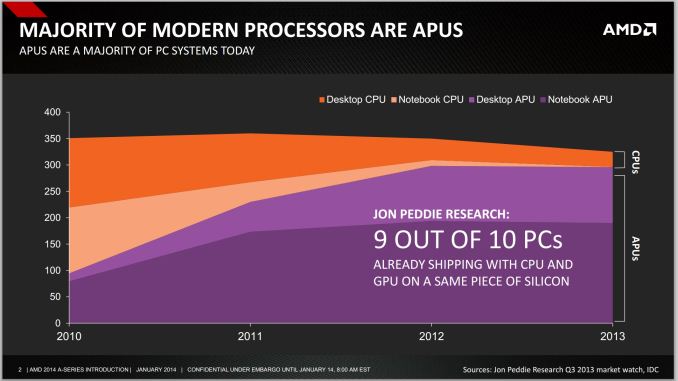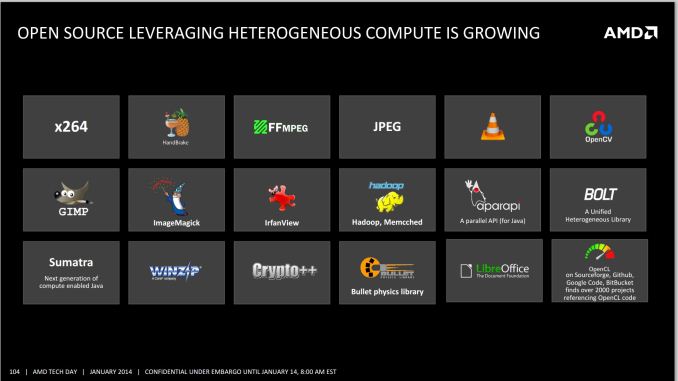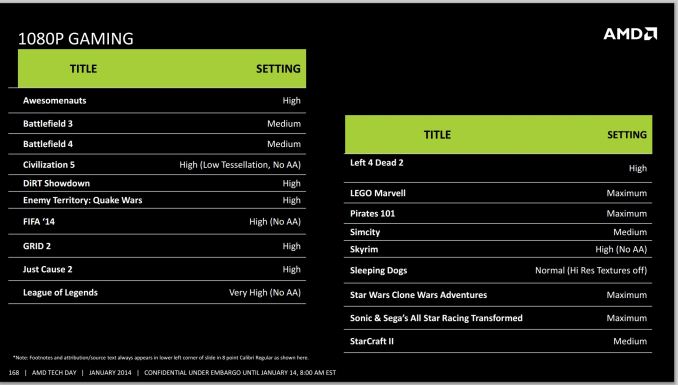AMD Kaveri Review: A8-7600 and A10-7850K Tested
by Ian Cutress & Rahul Garg on January 14, 2014 8:00 AM ESTKaveri: Aiming for 1080p30 and Compute
The numerical differences between Kaveri and Richland are easy enough to rattle off – later in the review we will be discussing these in depth – but at a high level AMD is aiming for a middle ground between the desktop model (CPU + discrete graphics) and Apple’s Mac Pro dream (offloading compute onto different discrete graphics cards) by doing the dream on a single processor. At AMD’s Kaveri tech day the following graph was thrown in front of journalists worldwide:
With Intel now on board, processor graphics is a big deal. You can argue whether or not AMD should continue to use the acronym APU instead of SoC, but the fact remains that it's tough to buy a CPU without an integrated GPU.
In the absence of vertical integration, software optimization always trails hardware availability. If you look at 2011 as the crossover year when APUs/SoCs took over the market, it's not much of a surprise that we haven't seen aggressive moves by software developers to truly leverage GPU compute. Part of the problem has been programming model, which AMD hopes to address with Kaveri and HSA. Kaveri enables a full heterogeneous unified memory architecture (hUMA), such that the integrated graphics topology can access the full breadth of memory that the CPU can, putting a 32GB enabled compute device into the hands of developers.
One of the complexities of compute is also time: getting the CPU and GPU to communicate to each other without HSA and hUMA requires an amount of overhead that is not trivial. For compute, this comes in the form of allowing the CPU and GPU to work on the same data set at the same time, effectively opening up all the compute to the same task without asynchronous calls to memory copies and expensive memory checks for coherency.
The issue AMD has with their HSA ecosystem is the need for developers to jump on board. The analogy oft cited is that on Day 1, iOS had very few apps, yet today has millions. Perhaps a small equivocation fallacy comes in here – Apple is able to manage their OS and system in its entirety, whereas AMD has to compete in the same space as non-HSA enabled products and lacks the control. Nevertheless, AMD is attempting to integrate programming tools for HSA (and OpenCL 2.0) as seamlessly as possible to all modern platforms via a HSA Instruction Layer (HSAIL). The goal is for programming languages like Java, C++ and C++ AMP, as well as common acceleration API libraries and toolkits to provide these features at little or no coding cost. This is something our resident compute guru Rahul will be looking at in further detail later on in the review.
On the gaming side, 30 FPS has been a goal for AMD’s integrated graphics solutions for a couple of generations now.
Arguably we could say that any game should be able to do 30 FPS if we turn down the settings far enough, but AMD has put at least one restriction on that: resolution. 1080p is a lofty goal to hold at 30 FPS with some of the more challenging titles of today. In our testing in this review, it was clear that users had a choice – start with a high resolution and turn the settings down, or keep the settings on medium-high and adjust the resolution. Games like BF4 and Crysis 3 are going to tax any graphics card, especially when additional DirectX 11 features come in to play (ambient occlusion, depth of field, global illumination, and bilateral filtering are some that AMD mention).













380 Comments
View All Comments
UtilityMax - Tuesday, January 14, 2014 - link
i5 CPUs don't have hyper-threading. So they're 4 core, 4 thread. Moreover, AMD advertizes the APU as four core (which do share a ton of stuff with each other). Comparing the new APU against the i5 is totally justified. There are a lot of people expecting the Kaveri APU to elbow past the i3, and maybe get closer to the i5. Of poor souls.ATLSHOGUN - Tuesday, January 14, 2014 - link
As a long-time AMD supporter (owner of athlon, x2, x4, x6, 8350 & a10) I am very disappointed. I feel like AMD has been lying to us for three years now. We were promised %30 gains and this is nowhere close to that. We were promised a high end steamroller chip and it appears we won't get that either.The clear truth is that AMD is now exclusively a low-mid range gaming chip designer. While these chips also do well in low-mid range laptops and desktops, AMD is no longer for the power-user nor do they want to be.
My next PC in around early 2016 will absolutely be Intel and I won't feel bad about switching off of this team full of lies and disappointment.
We should all be sad, because today is the day when competition in the cpu industry officially died.
andrewaggb - Tuesday, January 14, 2014 - link
Meh, it died a while ago. I had an amd 486 120, k6 200, k6-2 300, xp 1800, xp 2500, 64 3200, x2 4400, x2 6400, phenom 2 940, and later a phenom 2 965. That's a pretty solid customer. Since then I've had an i5 750, 2500k, 4570 in my desktops and i7's in my laptops. Intel is so clearly superior in cpu performance I just can't be bothered to give amd any money. I still buy their gpu's...mikato - Wednesday, January 15, 2014 - link
I have a Phenom II X4 965 also and love it, but when I do a rebuild of our 2nd gaming machine it will have to be back to Intel.gruffi - Tuesday, January 14, 2014 - link
This comparison is really stupid. i5 has 4 full cores or 4 FPUs. Kaveri still has only 2 modules or 2 FPUs. You should compare against i3, not i5. And from what I've seen so far, 65W Kaveri is on the level of the fastest Haswell i3. Which is an excellent result for AMD because they still have only 128-bit FMACs while Intel already uses a 256-bit FPU. So, Excavator will be quite interesting with its 256-bit FMACs.takeship - Tuesday, January 14, 2014 - link
Not even 95W Kaveri is as fast as an i3-4430, which is not the fastest i3. Perhaps if you can manage to get everything HSA accelerated, but not otherwise. AMD themselves claimed just last week that Kaveri would compete with i5s (hence the 7850k priced at ~190$). So the inclusion is valid.just4U - Wednesday, January 15, 2014 - link
You mean the 4330 yes? As the 4430 is the new starter i5... Anyway there is a argument that can be made in AMDs favor here.. People buying off the shelf bestbuy/walmart type specials with integrated graphics may get as good if not marginally better overall experience from the AMD build if the offset in hardware costs translates into something more being added into the AMD machine..However.. (and this is key..) knowing such companies it simply means higher profits for them at without having to worry about the buyer bringing the damn thing back because they crippled it so much to make the price appealing.
nos024 - Tuesday, January 14, 2014 - link
Tell that to AMD. They were targeting the i5 with their pre-launch slides so it's fair to test their claims. Seriously, I was hoping Kaveri would deliver, but it didn't. So just let it go. I don't even think the performance increase is worth the $50+ or so over Richland or Llano.asliarun - Tuesday, January 14, 2014 - link
Ian and Rahul, Kudos of an extremely thorough review. You must have really burnt the midnight oil to get this done.One request: Can you please post your thoughts on how good Kaveri will be for HTPC? I have increasingly been feeling that a compact box that can do HTPC and do mid-level gaming in a pinch would be a really good idea for the living room (and media cabinet). Kaveri seems to be purpose built for that. However, I don't find any info on Kaveri's HTPC capabilities.
Thanks!
mikato - Wednesday, January 15, 2014 - link
I agree! There isn't much info about how Kaveri fits into the various computer roles, and I'm interested in HTPC possibilities as well. It seems with its advantages in video, and plenty of CPU power for HTPC needs, that it would be an outstanding fit.